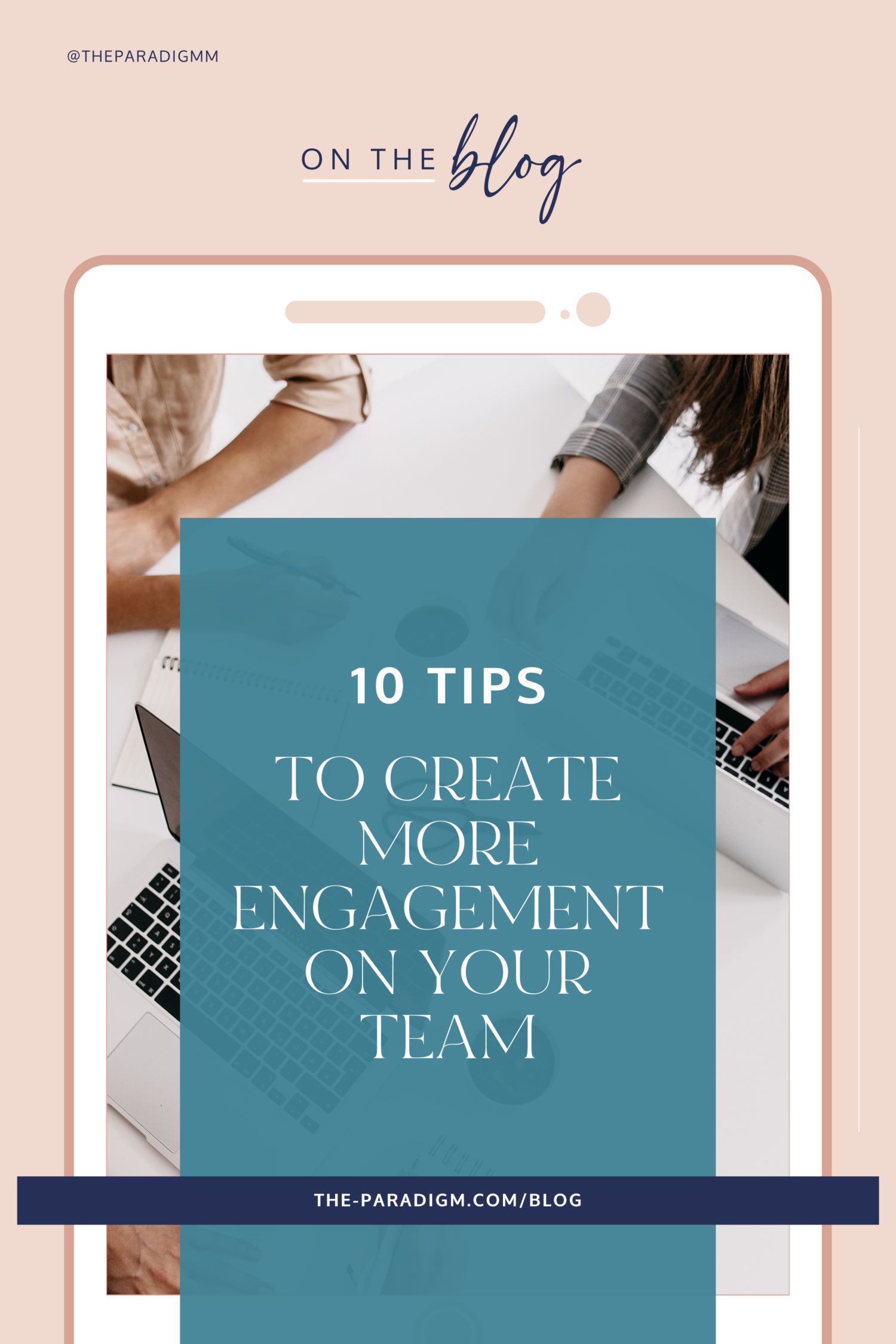February 15, 2022
Written by Kiley VanGilder, Lead HR and Operations Strategist at Paradigm People Operations Consulting.
Employee engagement can be somewhat of a roller coaster ride for employers. But that isn’t cause for panic. Every company will have growing pains and changes along the way. This is oftentimes a result of a shift in their company culture.
Being able to adapt to these changes, create buy-in, and have the tools readily available to manage the team is a sure way to improve employee engagement. You can keep everyone off the wooden roller coaster, and on the smooth ride we all want to be on.
High employee engagement means your company is more likely to have higher profitability, productivity, morale, and retention. Sounds great, right? Well it is. While it’s important to have a well thought-out engagement strategy, there are some low-lift initiatives you can implement immediately while working on the company’s long-term strategy. Let’s dive in!
1. Honesty and Transparency
Let’s be honest, one of the most powerful ways to build employee engagement is by being HONEST. Honesty builds trust, which in turn builds a stronger working relationship. When you have a strong working relationship, employees are more likely to be bought-in to the company and want to do their very best work for you.
Being transparent doesn’t mean you need to tell your employees every detail of the business. Instead, share key information, and determine early on how transparent you want to be with your employees. For example, some companies share their revenue openly with the team. Don’t feel obligated to share this information if you’re uncomfortable. But if an employee asks you about company revenue, never lie. Instead you can politely explain that you’re not ready to share this information, but you are thankful they care so much about the company and you value what they do. Setting boundaries early on is a great way to shape your company culture, and set a tone for what is and is not acceptable.
2. Trust and Allowing Room for Errors
Trust your employee to make the right decision, and support them when they don’t.
Engaged and creative employees will be built with this practice. If you’re too quick to jump into your company’s discipline policy and aren’t providing regular constructive feedback, employee’s will lack trust and feel a sense of fear. (Of course if there are red flags around employee performance, taking action to help improve their performance immediately is always recommended.)
When an employee is not afraid to make a mistake, they feel trusted and more at ease to do their job effectively. Fear of not being perfect doesn’t take up their thoughts. And let’s be honest here, at some point, most of us have felt pressure from a company to be perfect. Afraid of what happens if a mistake is made. I don’t know about you, but I’ve mentally checked out of a job due to the stress of trying to be perfect for that role. My engagement was low, and so was my morale and it ultimately lead to me leaving the company – costing the company A LOT (turnover is a huge money and time sucker for employers).
Room for error also brings about a sense of creativity that companies who try to limit error might not find in employees. For example, an employee who feels trusted might go out on a limb and test out a new software, which might ultimately enhance your teams productivity rates, all because the employee knew they had your trust. Creativity can almost always be found inside a trusting working relationship.
3. Effective Listening
Teams with high employee engagement are paying close attention to their employees feedback and then acting upon it. Not only does this create a situation for an employee to feel valued, it also allows you to find minor problems and find a solution to them before they turn into something bigger and more problematic. Companies who don’t gather feedback or aren’t acting upon the feedback received are more likely to see higher turnover rates and lower team morale. Employees who feel heard and see change based on their voice are more likely to stay engaged in their work and find greater value in the company.
Employee engagement is one big math problem, really:
Honesty + Trust(Effective listening + acting upon feedback) = Increased Employee Engagement
Paradigm’s Solution: Instead of offering yearly surveys to gather employee feedback, begin incorporating surveys more frequently. We suggest sending out check-in forms once a month, to get a pulse on how the team is doing. Try scheduling a meeting with your leadership team quarterly to review this feedback and find ways to improve things within your business. After, thank the employee for their recommendation and let them know of the new process rolling out because of them!
4. Strengthen the Onboarding Process
Employers aren’t the only ones looking for top candidates. Employees are doing the same. Just as you are carefully watching performance during an employee’s introductory period, the employee is doing the same of the company. Having a well put together onboarding process is essential to keeping the stellar employees we all hope to find (and keep forever). It allows the employee to see that you have built a company culture and they have a place in it.
Onboarding is a time to set to the stage and talk through all the important details that mean so much to you and that you’ve worked so hard to build – the company mission, vision, values, and the policies that protect the employee and the company. It gives you a chance to talk about the how and the whys of the company and the importance of the employee’s role, giving them a sense of responsibility and importance. It is truly just as important to bring a company’s “A game” to the onboarding process, as it is any other process in a company.
5. Remember We Are All Human
You’re on your 15th sales call of the week, you’re feeling burn out and don’t feel like checking in with your employees because you are simply T I R E D. Your team is probably fine, right!? If you’re feeling tired, chances are you team is too. The most powerful thing you can do during these times is to remember you’re all human and burnout is real and can hurt a company if not taken seriously. Check in with employees after a big launch, or after some weeks of focused, hard work.
“Hey, I’m feeling tired and I know you might be to. We’ve done some tremendous work recently! How are things going? Is there anything I can help you with or we table until next week?” Small acts of kindness like this can really set the tone for your team and build better engagement after you all get the R&R needed!
6. Recognizing and Rewarding Hard Work
You will almost always see an engaged employee going the extra mile to get the job done. We love to see it, am I right? They are the “trophy employees” that we wish we could clone and have an entire army of. Even the top performers enjoy recognition of some sort. Try incorporating positive feedback and recognition within your company often and early on. As constructive feedback is likely a part of your company culture, positive feedback should be as well!
Of course promotions are one of the the ultimate ways to say thanks to top employees when a company is ready for additional growth. Don’t feel obligated to promote if your company is not ready or cannot financially afford it. There are other ways to keep employees engaged and recognize them. Lets take a look at a few of our favorites…
- Encourage your management team to incorporate positive recognition as a part of their daily communications with team members.
- Create a system to send out monthly recognition emails to the team.
- Encourage peer to peer recognition.
- Offer additional projects that help with professional development
- Reward with non-cash items such as a gift card, or a gifted paid day off to use when they want.
- Reflect the hard work of the employee in a performance evaluation and compensation review.
7. Team Building Events- Have Fun!
Work doesn’t have to be all work no play ALL of the time. Try hosting an in-person team building event annually for your remote squad. This is a great time to encourage team building efforts and let’s employees get to know each other outside of their day to day work. Take the time to build an itinerary that encourages team building, professional development, and FUN.
8. Professional Development
Just as we leaders love to grow and educate ourselves, our employees do to! Employees are likely to be more engaged with their day-to-day work when they are offered resources to continue growing professionally. A simple but highly effective way to encourage employee education is to offer professional development days. This is a win-win because you get to block off time to really learn more about your employees while also being able to offer them educational tools that they can then incorporate into their daily work.
Try purchasing a course or book related to their interest and let them spend the day diving into all things marketing, or whatever topic it is they want to learn more about. Investing in your employee, is also investing in your company.
9. Measure What Truly Matters in Employee Performance
Employee’s want to feel valued and create value. When companies have too many measurements, especially ones that don’t truly matter, employees might start to feel disengaged. Instead of creating a KPI for every possible item in a job description, be intentional in the creation of KPIs. This will clearly lay out what is expected of an employee and create more intentional work that employees can feel proud of. It also gives more flexibility and freedom in the workspace, which can give employees a sense of trust and confidence, while also letting some creativity flow.
10. Give Employees the Proper Tools to Succeed
This sounds like a “well obviously” tip, but it’s often overlooked. Providing the necessary tools for employees to succeed in their role is a must. Make sure all employees have a computer, desk, chair, mouse and other basic necessities. If they don’t, or if something breaks, try offering a tech stipend so employees can easily and quickly replace items. Many companies include a tech stipend in their benefits package now a days.
Another set of v. important tools, the software (SaaS) used in your company. Making sure employees have high level overviews of your software and are set to independently work throughout programs will increase productivity, reduce frustrations, and create a smoother workflow. We recommend reviewing your tech/programs at least once a year to make sure it’s still an integral part of your business. If it’s not – ditch it! Less tech = smoother workflows = more engaged employees.
Employee Engagement: Final Thoughts
Employee engagement is absolutely essential to a company. When employees check out and are no longer engaged, your business suffers, your bank account suffers, and morale plummets. Try out these highly effective solutions and see how quickly engagement increases.
Need help building the company culture of your dreams? Join Set to Scale to start building foundations for an engaged, kick ass team!

